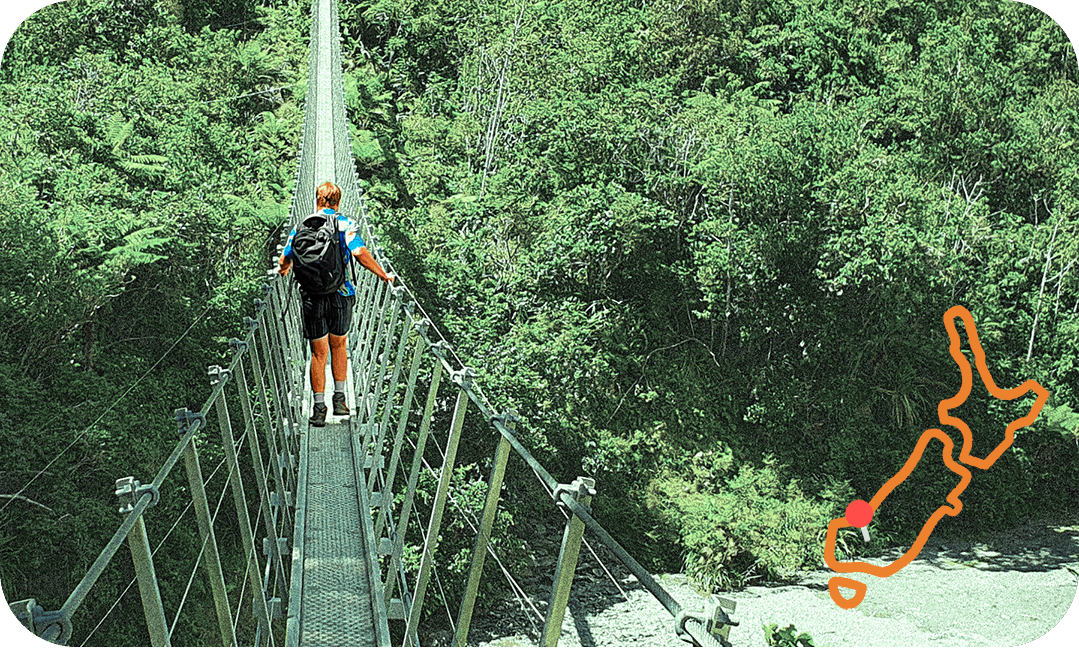In this story from the Electric Highway, Don Rowe’s deeper explorations find him reconsidering everything he thought he knew about hiking.
Halfway up Roy’s Peak I was done. Dragging 100 kilograms of Covid bod and Christmas beers, I had been broken by the merciless heat, endless dusty switchbacks and the many middle-aged weekend warriors happily jogging past my corpse on their way up 1250 metres of elevation.
The view from the top is stunning, but it’s not until you haul your new year’s resolutions over the final hump in the track that the full 280-degree vista becomes apparent. For most of the slog it’s the same perspective at 50 metre intervals interspersed with sheep and the occasional quail. And it’s the same lake – and the same mountain – you can see lying on the waterfront with a cold beverage. “Hikers are frauds,” I thought to myself. “Nobody honestly enjoys this.” But that’s not true.
—
This story from the Electric Highway is brought to you by BMW i, pioneering the new era of electric vehicles. Keep an eye out for new chapters in Don’s journey each week, and to learn more about the style, power and sustainability of the all-electric BMW i model range, visit bmw.co.nz.
—
I’ve spent plenty of time outdoors, hunting Te Urewera and the Harkness and the Te Puke Tops. Long hours spent fighting through supplejack, snagged on thorns, bluffed on precarious inclines and dealing with the endless vociferous biting sandflies. That stuff always seemed incidental, an obstacle to the end goal of bagging a deer, something to be suffered through on your way to a singular moment of triumph. But there is an undeniable grim satisfaction to having endured, and a grudging appreciation for the beauty of the bastard moss dripping freezing dew down your boots. And within that maybe the seeds of enjoying a hike too.
Because like the thorns are a prerequisite to that moment of stalking in on an animal, where the fatigue is pushed aside like the spiderwebs across the track, the potential for the difficulty of a hike to evaporate always exists around the next bend, when the sun reflects perfectly off the lake or the mist rolls over the hills like an ocean in the sky. It’s the closest I’ve come to understanding a long distance runner’s high, a condition I’ve never pushed myself far enough to properly experience.
After the almost 16 kilometre slog up Roy’s Peak, I was hooked. Over the next few weeks I hiked again, and again, and again. And every time it felt better. From short stints to jump in the Blue Pools, to a quick nip up to Wombat Lake, if I saw that iconic green and yellow DOC sign, I was pulling over.
And while it feels as though there’s a breathtaking view off the side of almost every main road in New Zealand (because there is), the scenic route always rewards deeper exploration. The juddering metal tracks, surface water and trails bordering precipitous drops along which I pushed the BMW iX only served to emphasise the frontier feeling that seeps in when you travel the deep south. And unencumbered by the petrol pump, I found myself keener to explore now that I wasn’t measuring the vast stretches of the South Island in dollar signs.
Like most people, the idea of walking as far as the supermarket without headphones inspires within me deep unease. To be left alone with my thoughts and nary a parasocial relationship with the podcast host of the month seems almost incomprehensible at home. But on the track, listening to something other than the wind in the trees or the rushing of water is akin to taking a spa bath in a wetsuit. The crunching of gravel is like a metronome for the rhythm of the present moment, and I felt myself slowing down, enjoying walking for its own sake, and not viewing the path as an obstacle between myself and some end goal.
Near Fox Glacier I drove 10km through deep bush down an unsettlingly narrow, rugged and remote gravel road, past the graves of colonial miners at the 126-year-old cemetery, and walked out onto Gillespies Beach. The rocky shore extends endlessly in both directions, with frothing tides dragging north along the coast. It’s an empty, melancholy sort of place typical of the West Coast; walking along the stones you could be an early pioneer, or a post-apocalyptic drifter.
Five hours up the Alex Knob track above Franz Josef offers many glimpses across glacier country. The raw forces at work on the landscape at dusk are astonishing. Huge boulders the size of trucks carried down from the glacier, thrown across the river bed before coming to rest like islands in the torrent. Under the trees, the place feels prehistoric, with huge rata climbing and grasping around the trunks of the rainforest, groaning in the moody breeze. There’s little light beneath the rainforest canopy, and off to either side of the track feels forbidden by something more than the signage. The huge effects on the landscape are a testament to primordial forces, the workings of Tane and Tawhirimatea, Rūamoko and Tangaroa. It’s a reminder that while the glaciers recede and things look pretty grim for humanity, the earth has undergone catastrophic changes, huge flows of lava and choking smoke, crippling ice ages and tectonic shifts that drove mountains towards the sky. Nature measures time across millenia, and eventually some semblance of balance will be reached.
But for those of us who will be lucky to see 100, there has never been a better time to explore.


